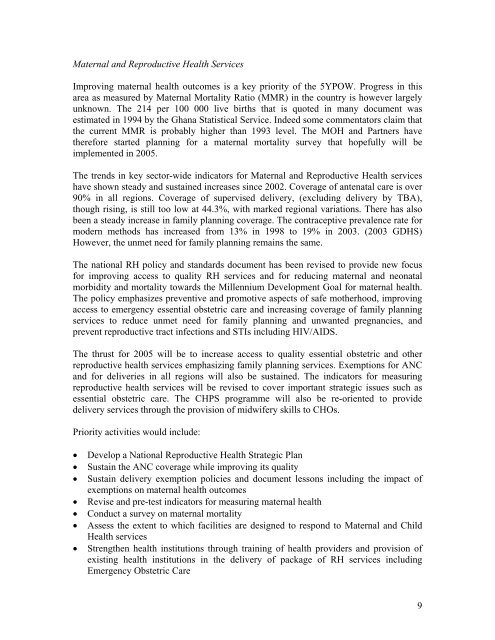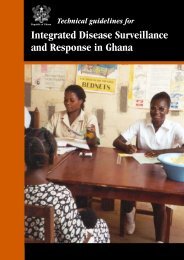Annual Programme of Work 2005 - Ministry of Health
Annual Programme of Work 2005 - Ministry of Health
Annual Programme of Work 2005 - Ministry of Health
You also want an ePaper? Increase the reach of your titles
YUMPU automatically turns print PDFs into web optimized ePapers that Google loves.
Maternal and Reproductive <strong>Health</strong> Services<br />
Improving maternal health outcomes is a key priority <strong>of</strong> the 5YPOW. Progress in this<br />
area as measured by Maternal Mortality Ratio (MMR) in the country is however largely<br />
unknown. The 214 per 100 000 live births that is quoted in many document was<br />
estimated in 1994 by the Ghana Statistical Service. Indeed some commentators claim that<br />
the current MMR is probably higher than 1993 level. The MOH and Partners have<br />
therefore started planning for a maternal mortality survey that hopefully will be<br />
implemented in <strong>2005</strong>.<br />
The trends in key sector-wide indicators for Maternal and Reproductive <strong>Health</strong> services<br />
have shown steady and sustained increases since 2002. Coverage <strong>of</strong> antenatal care is over<br />
90% in all regions. Coverage <strong>of</strong> supervised delivery, (excluding delivery by TBA),<br />
though rising, is still too low at 44.3%, with marked regional variations. There has also<br />
been a steady increase in family planning coverage. The contraceptive prevalence rate for<br />
modern methods has increased from 13% in 1998 to 19% in 2003. (2003 GDHS)<br />
However, the unmet need for family planning remains the same.<br />
The national RH policy and standards document has been revised to provide new focus<br />
for improving access to quality RH services and for reducing maternal and neonatal<br />
morbidity and mortality towards the Millennium Development Goal for maternal health.<br />
The policy emphasizes preventive and promotive aspects <strong>of</strong> safe motherhood, improving<br />
access to emergency essential obstetric care and increasing coverage <strong>of</strong> family planning<br />
services to reduce unmet need for family planning and unwanted pregnancies, and<br />
prevent reproductive tract infections and STIs including HIV/AIDS.<br />
The thrust for <strong>2005</strong> will be to increase access to quality essential obstetric and other<br />
reproductive health services emphasizing family planning services. Exemptions for ANC<br />
and for deliveries in all regions will also be sustained. The indicators for measuring<br />
reproductive health services will be revised to cover important strategic issues such as<br />
essential obstetric care. The CHPS programme will also be re-oriented to provide<br />
delivery services through the provision <strong>of</strong> midwifery skills to CHOs.<br />
Priority activities would include:<br />
• Develop a National Reproductive <strong>Health</strong> Strategic Plan<br />
• Sustain the ANC coverage while improving its quality<br />
• Sustain delivery exemption policies and document lessons including the impact <strong>of</strong><br />
exemptions on maternal health outcomes<br />
• Revise and pre-test indicators for measuring maternal health<br />
• Conduct a survey on maternal mortality<br />
• Assess the extent to which facilities are designed to respond to Maternal and Child<br />
<strong>Health</strong> services<br />
• Strengthen health institutions through training <strong>of</strong> health providers and provision <strong>of</strong><br />
existing health institutions in the delivery <strong>of</strong> package <strong>of</strong> RH services including<br />
Emergency Obstetric Care<br />
9















